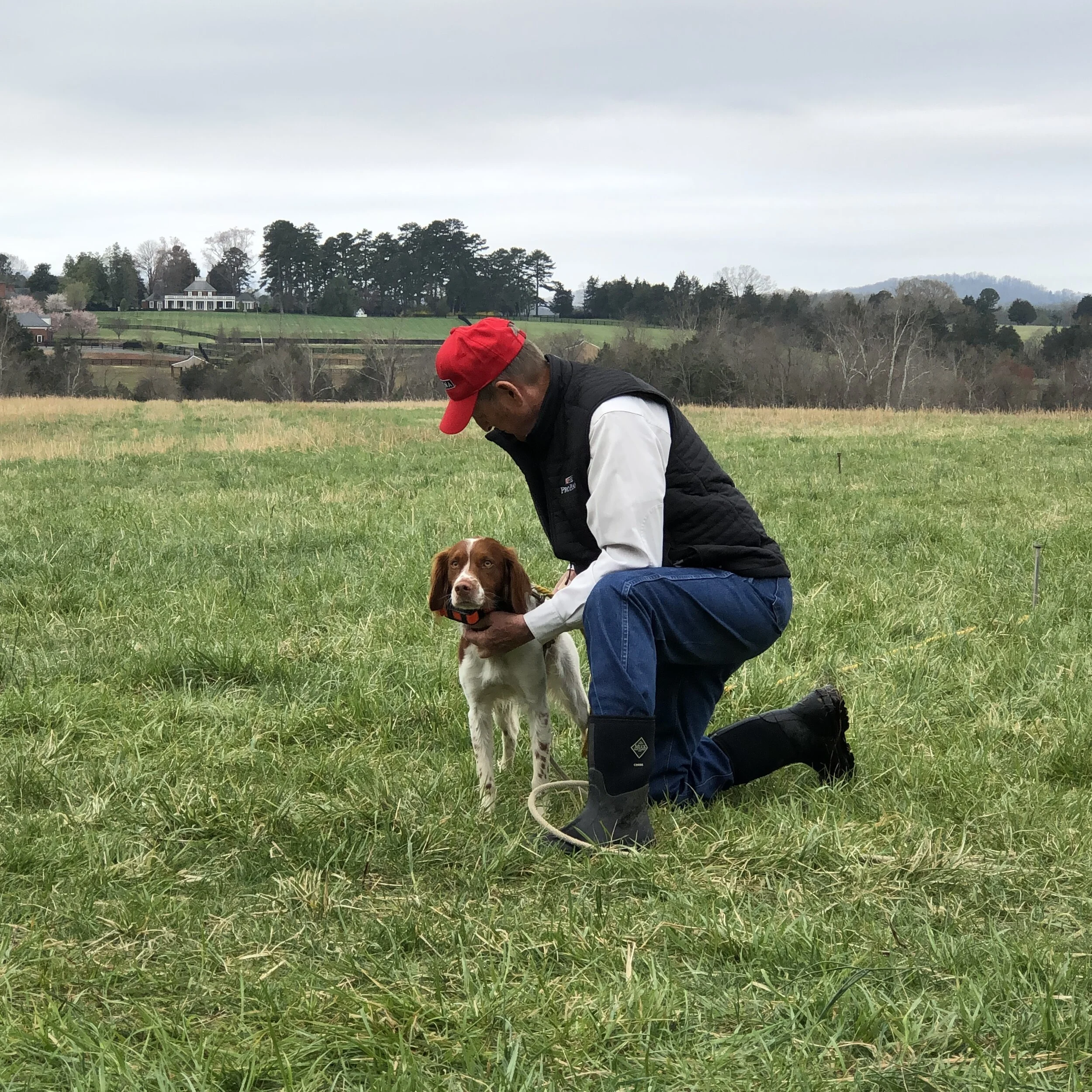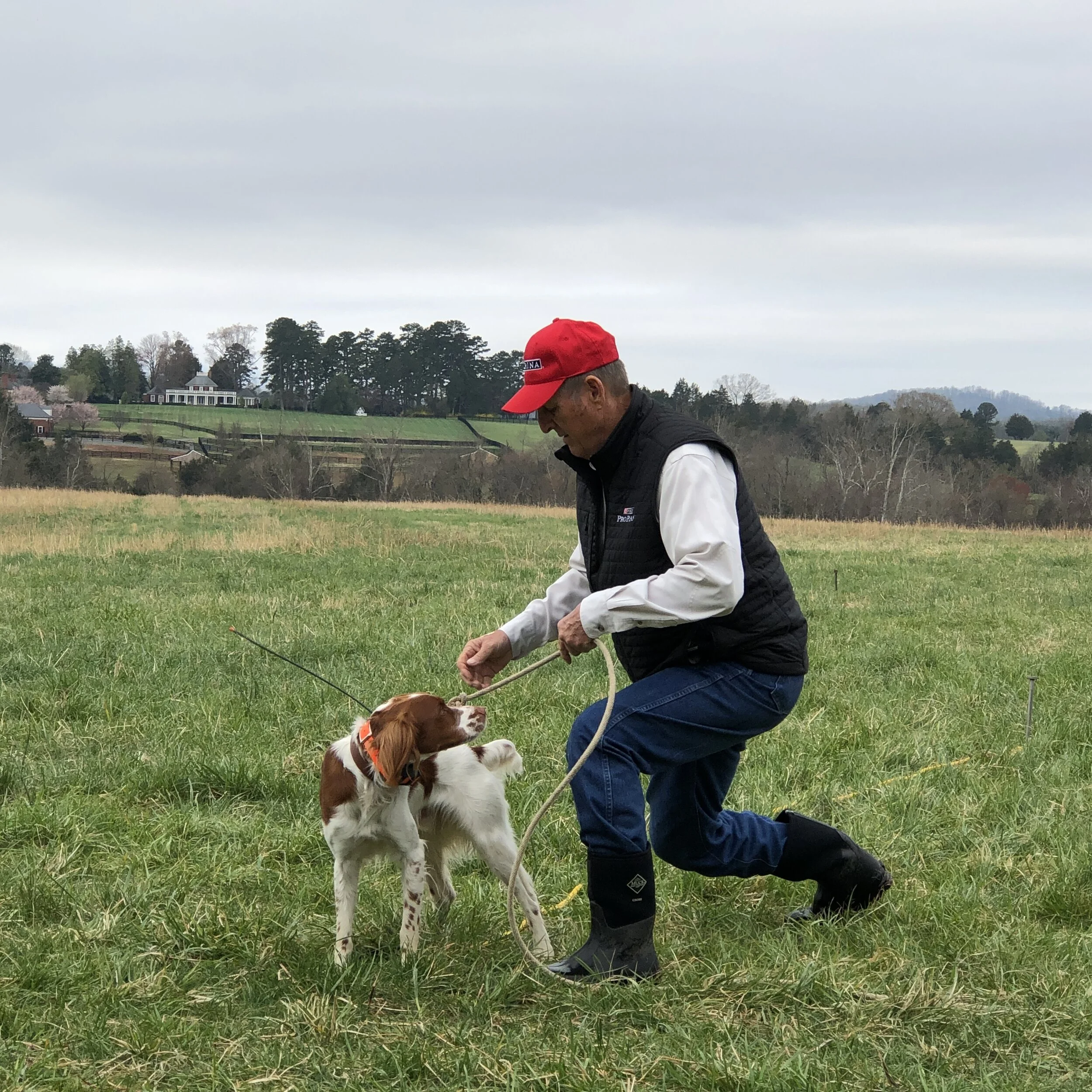Rick Smith: Bird Dog Royalty in the Great Commonwealth of Virginia
When upland hunters and bird dog enthusiasts world-wide hear the name “Rick Smith,” they will immediately know we’re talking about one of the most famous bird dog trainers in the world today. They’d no doubt be able to tell you that Rick is a member of the Bird Dog Hall of Fame, is the son of the legendary Delmar Smith (still active at the age of 93), is the grandson of the legendary B.F. “Dutch” Epperson, and that he created the wildly-popular Huntsmith Silent Command System of bird dog training along with his cousin Ronnie Smith. But, if you were to ask those same upland hunters and bird dog enthusiasts where Rick might live, I’d be willing to bet the vast majority would offer Oklahoma as their best guess. For much of his life, they’d have been right. Even dedicated bird dog folks in Virginia might be forgiven for not realizing that this scion of bird dog royalty actually moves and dwells among us, that is when he’s not off to far-flung outposts of birddogdom across the nation and world, presiding over his and Ronnie’s popular weekend Huntsmith Training seminars. For the past decade, Rick has in fact lived right here in central Virginia.
Now all this could be the prelude to a lamentable description of a “cobbler’s kids have no shoes” sort of situation, and our great commonwealth might not benefit at all by Rick’s residency, so punishing is his travel schedule and demand for his instruction nationally and internationally. When I started out with Lincoln, I assumed that was the case. Lincoln’s breeder, Todd Parmenter of Dogwood Brittanys in Peoria, Illinois, had first suggested Rick as the instructor, and Huntsmith as the system, they most recommended for their dogs among the panoply of great options available today, many of which claim Delmar, Rick, Ronnie, and The Huntsmith Training Method as some greater or lesser part of their philosophical DNA. Todd off-handedly mentioned to me early on that “I think Rick actually lives somewhere near you.” Eagerly following up on Todd’s lead, I noted an 804 area code in the contact references for Rick on the Huntsmith website but was disappointed that there was no description of a local kennel or training operation and assumed Rick spent the vast majority of his time traveling and probably valued his privacy and downtime when at home in Virginia (exactly where, we weren’t entirely sure). While I’m sure that’s rightly the case, I only later learned his incredible generosity as a teacher and mentor was not withheld from his fellow Virginians in his adopted home.
Introductions
My yellow brick road to Rick and Huntsmith started with Jane and Neal Kauder, owners and proprietors of the Orapax Hunting Preserve, the dear friends who provide me with open access to their spectacular grounds and birds with which to regularly train Lincoln (Orapax’s dog training membership is a true gem and rare bargain for beginners), and the consistent encouragement someone new to training a bird dog for both home and field needs. By luck or divine beneficence, the Kauders turned out to be friends with Rick, and were themselves enthusiastic proponents of the Huntsmith training system for folks like me: urban dwellers who have bird dogs who live in the home, and who therefore need rigorous manners and obedience training every bit as much as bird dog field training.
I had my first opportunity to meet Rick at a day-long obedience seminar for working dogs held last year at Orapax where he attended as a special guest star to sit for a no-holds-barred Q&A session over lunch with the day’s 15 or so attendees. Safe to say we were all awed by the opportunity we had to meet Rick and ask him questions in such a small, intimate forum. Despite his and his family’s towering reputation in the bird dog world, you won’t meet a nicer, more down-to-earth, or more generous guy. Both of my late grandfathers were Virginian small game and bird hunters, and maybe because Rick may now be about the age they were when I was a small boy, I couldn’t help but notice that he seemed like some sort of magic combination of the two of them - in expressions and personality and even sense of humor. I can’t quite describe it, but meeting him, I was struck by this feeling that my grandfathers’ wisdom and love for dogs and small game hunting traditions, now by Lincoln activated in me after long dormancy, had found a cosmic conduit through Rick.
Apart from how much I immediately Iiked Rick and felt a kinship with him, several other things stand out in my memory of that day. The first was realizing just how much I had to learn from Rick despite thinking I’d done a pretty good job training Lincoln to that point. While Lincoln sometimes - even often - obeyed me at heel and in some of the other routine tasks we had worked on over the countless mornings of our solo training, he wasn’t nearly as consistent as I imagined him to be nor at all immune to the distractions that other dogs and people provide. This was made quickly evident as each of the participants was called upon to demonstrate whatever proficiency they had in heel work, on and off leash. I also learned I had plenty of company in having a lot to learn.
Despite how much I liked Rick and how much in awe I was of him, I admit that I started that day with some prejudices about the Smith method that I’d picked up from others and which I bet at least some reading this harbor as well. I wasn’t at all sure how I felt about some of the core Huntsmith techniques: the whoa post; the flank collar; and the strict, demanding obedience tasks and the rigorous yard work upon which the system absolutely insists. Rick is the first to admit the Huntsmith system isn’t for everyone (he will usually say, with more than a slight grin, it’s not for those who aren’t yet tired of the out of control and belligerent ways their dogs are acting). Put starkly, positive reinforcement purists need not apply. But to hear Rick speak in depth on the topic for the first time, it was impossible for me to resist the wisdom of his cousin Ronnie’s expression, “if you treat your dog like a human, your dog will treat you like a dog.” Put another way, we have to give up some of our own hangups to be the leader, trainer, and mentor our dogs need us to be.
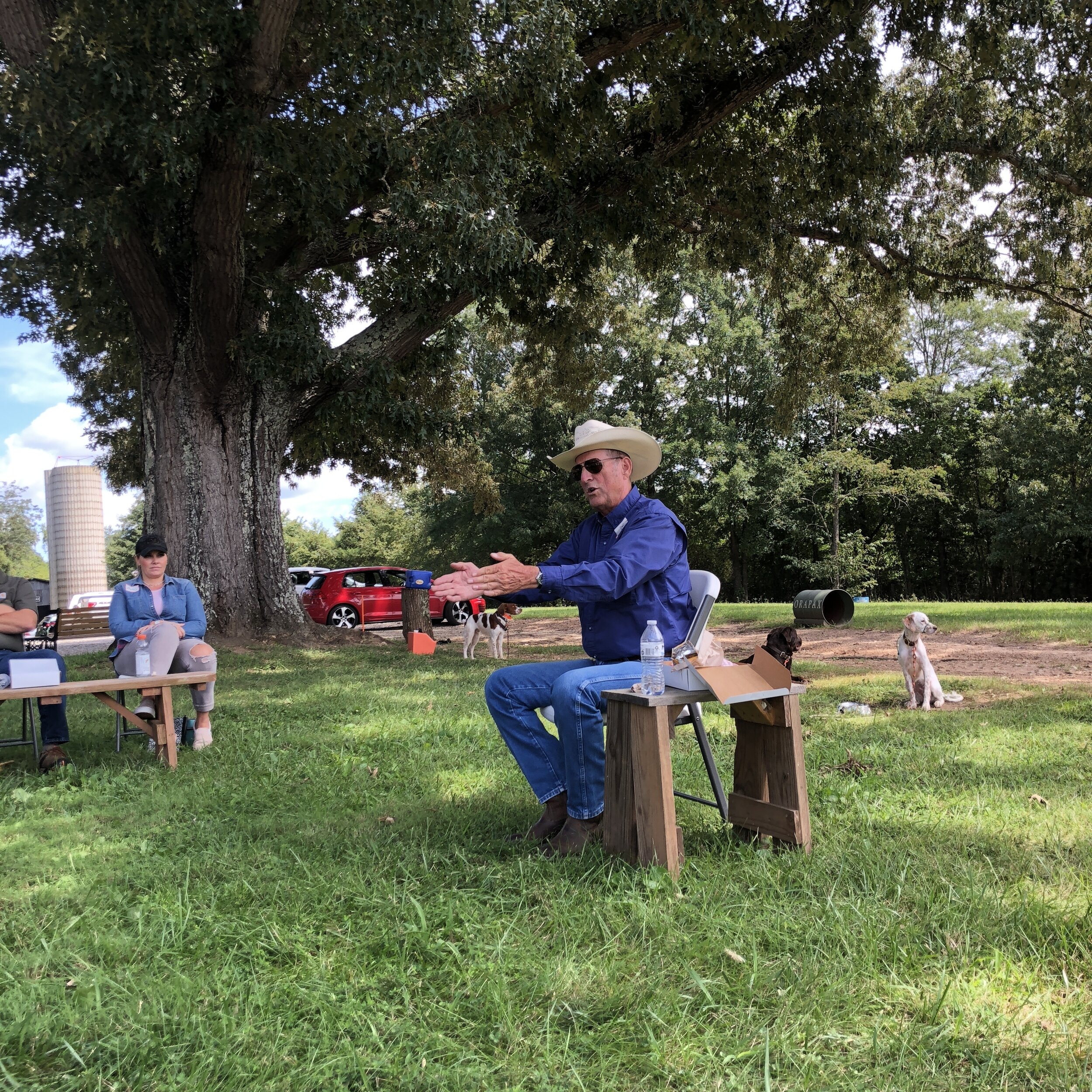
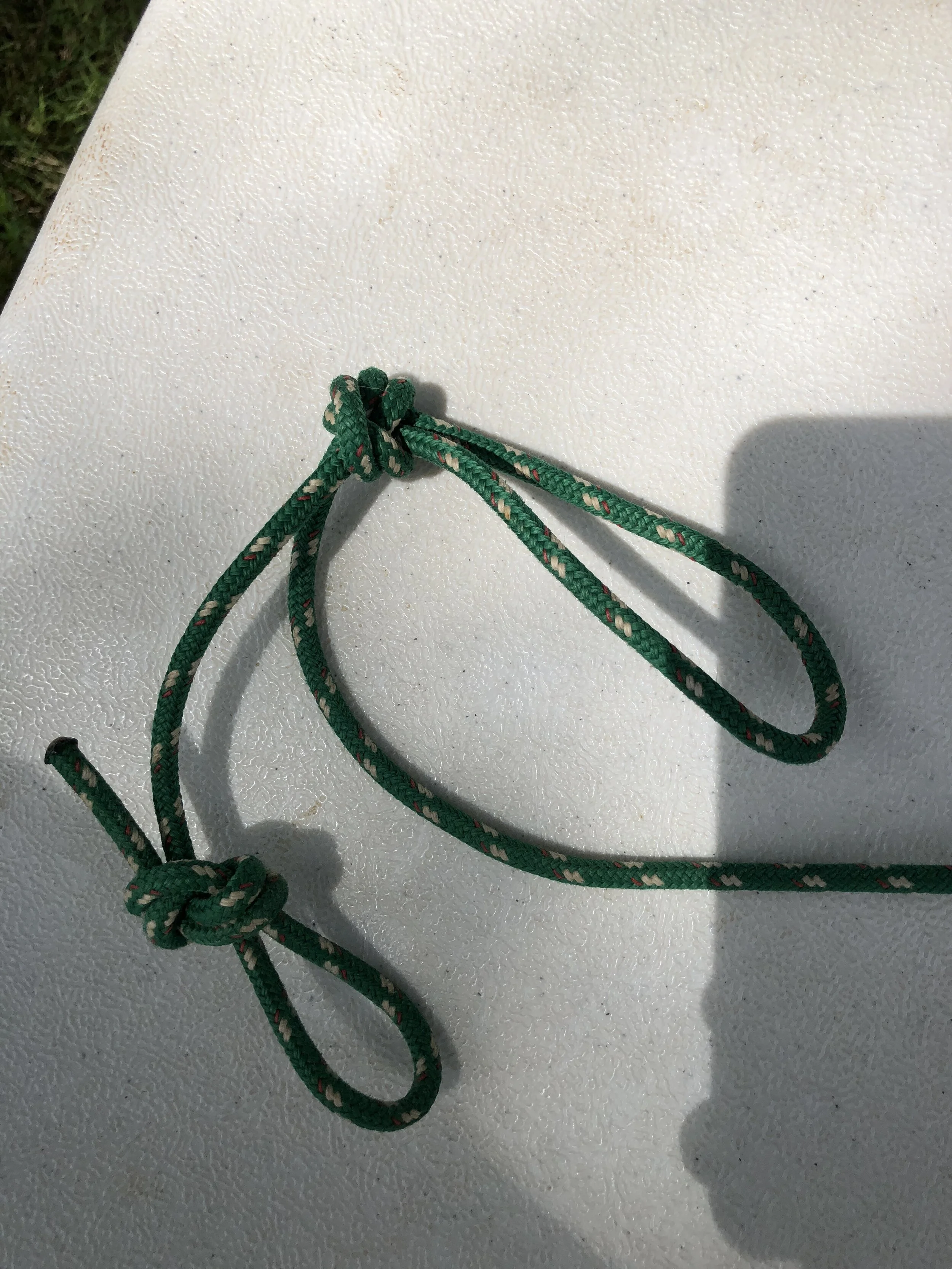
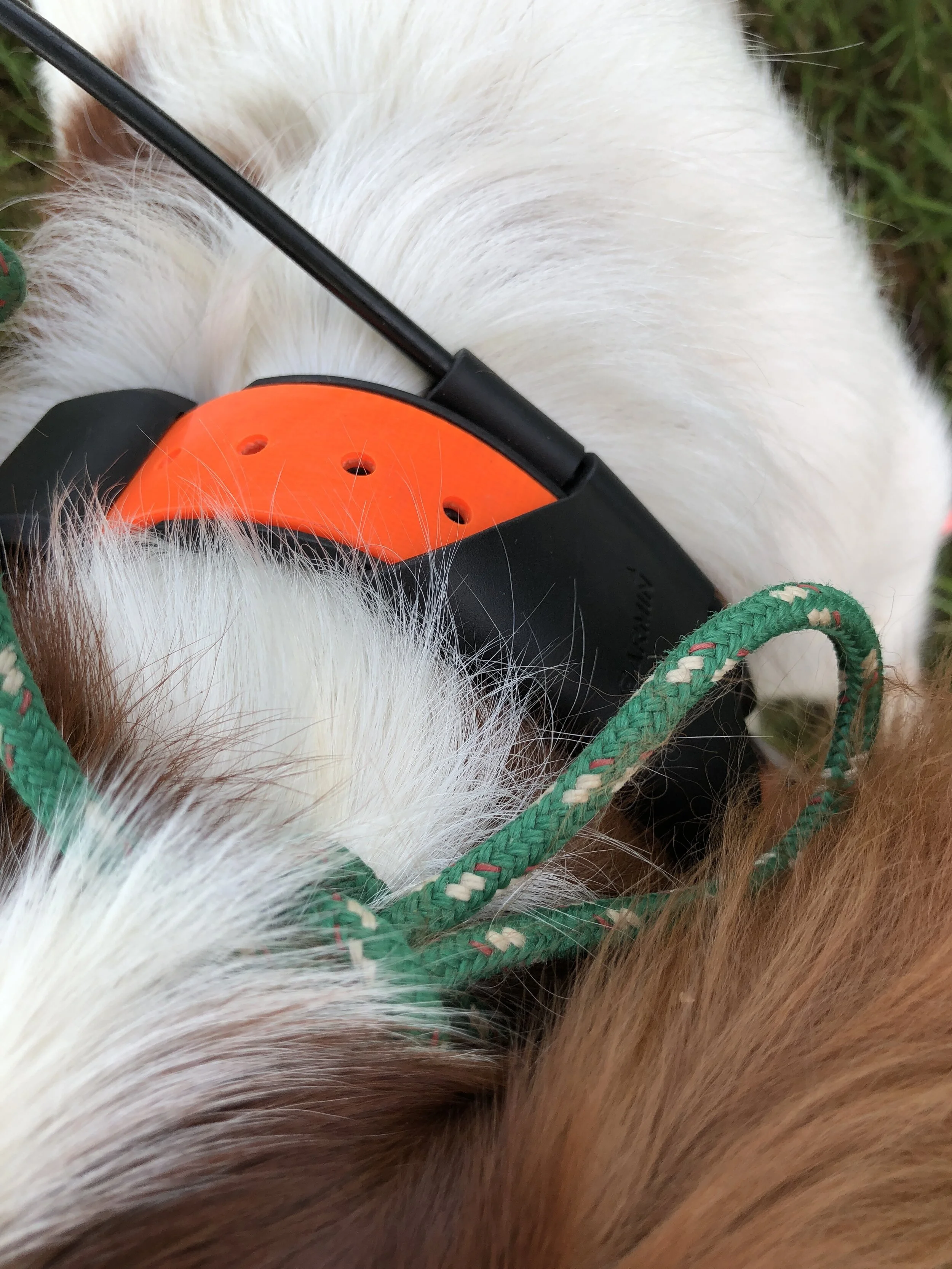

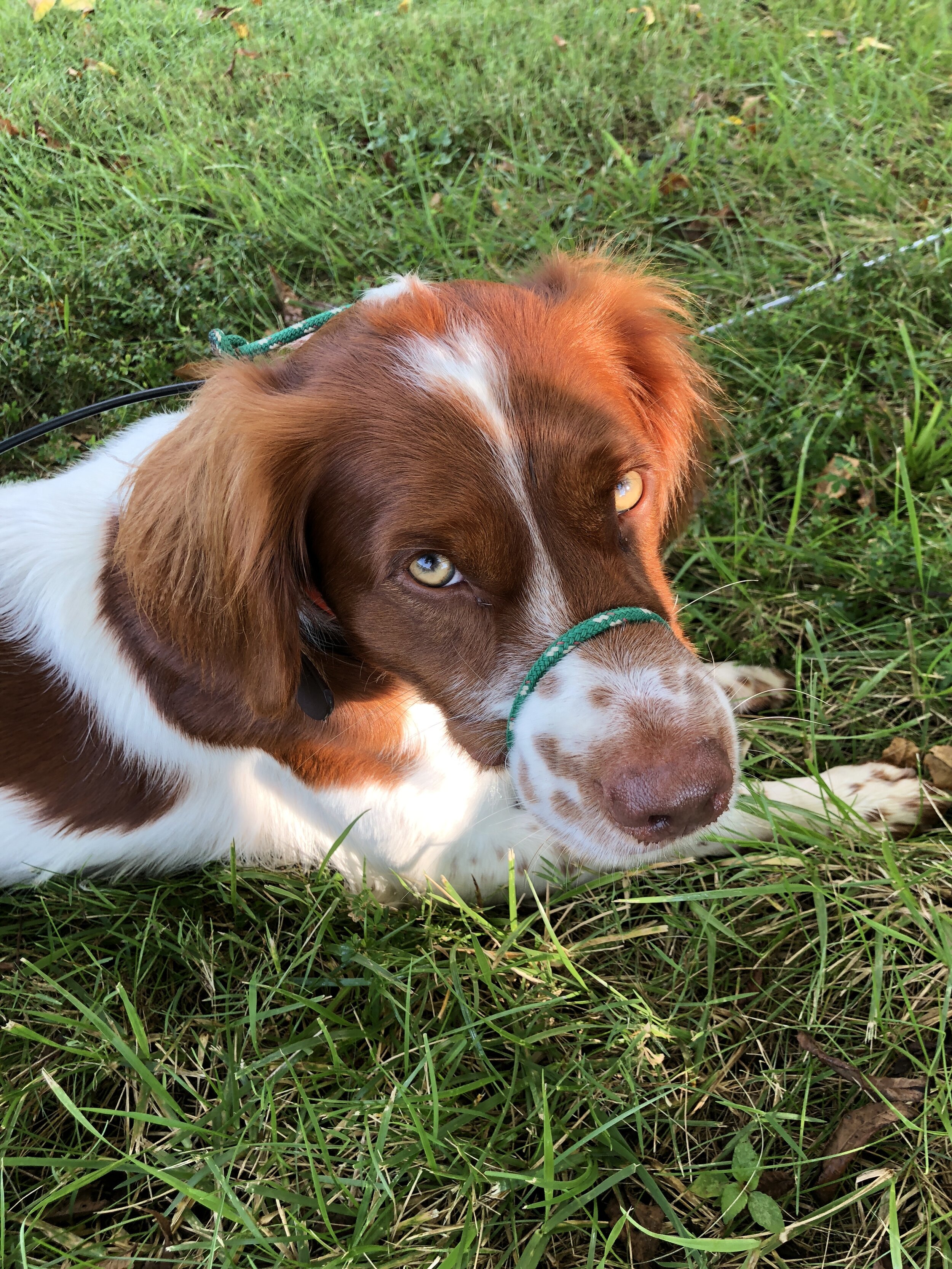

My other clearest memory of that day was being blown away by the transformation of a group of dogs on the tie-out cable (commonly referred to as the “chain gang”) when they weren’t allowed to demand attention through fits and barking. This was accomplished by applying a Huntsmith Figure Eight to any dog who was throwing a fit on the chain gang. This little device is a simple cord tied with a bowline knot at one end and a larger overhand knot to slide over a dog’s snout and mouth, secured by a slip knot that’s easy for a handler to release when the dog complies. It’s essentially a make-shift muzzle and in no way impedes the dog’s breathing or even drinking (though it should never be left on an unattended dog). What is does, however, is take away what is often a last hold-out of a dog’s resistance to her or his handler in resisting any particular command: its mouth (barking, whining, etc.). Used early on in the training process on the tie-out cable, it can accelerate the process of a dog giving into the restriction of being put on the cable, with other dogs, until they quietly await their handlers’ release into the yard for training or into the field to hunt. Rick explained the tool to us and had us apply them to our dogs when they were barking and it was amazing how quickly the dogs came to understand that they were expected to be relaxed and calm on the tie-out cable while waiting their turn for instruction or work in the field. Quickly, we witnessed a rowdy bunch of malcontents transform into calm and at-ease working dogs, waiting patiently for whatever interesting work project their handlers would supply next. Seeing that result, knowing I’d gritted my teeth for several months as my pup barked his head off whenever he was put on a chain waiting for his pass into the field, I was hooked and knew I had to learn much more about this method.
Huntsmith DVDs and seminars: necessary foundations
My next opportunity to do that came as Neal Kauder encouraged me to 1) buy the Huntsmith DVDs to get a full overview of the system, and 2) attend Rick’s Huntsmith Foundation Seminar this past spring at Peter Easter’s Spring Haven Farm outside of Charlottesville. Having committed to an introductory viewing of the DVDs before that seminar, everything clicked into place. For the first time, I felt like I was beginning to understand the core aspects and the most important lessons of this highly effective bird dog training system and program.
Having attended one, I’d say the full weekend intensive Huntsmith seminars are necessary for deepening one’s understanding of the lessons the system offers beyond what viewings of the videos can achieve. The DVDs are great for previewing the concepts of “standing still, going with us and coming to us,” (first using the Wonder Lead, and then the check cord, and then later still the ecollar) and for reinforcing the concepts after attending the seminars. But there’s so much more that you get from seeing Rick in action, trying out each step yourself with some coaching, asking questions about your specific dog, and seeing the process of experts addressing individual problems. The most powerful part of that seminar for me was seeing the whoa post process in person and beginning to understand its place in the formal Huntsmith method as a foundational prerequisite for the flank collar, which is itself also only a temporary step, ultimately leading to all cues being delivered via the neck ecollar. I came away not only with my concerns placated, but actually excited to work through a few weeks (3 posts, 2-3 times daily) of the whoa post with Lincoln, having had several chances to try my hand at it with Lincoln under the tutelage of Rick and the other trainers at the seminar.
Training inspired by the Huntsmith Method at Orapax: ongoing weekly training and coaching
I’ve had the good fortune to build upon those introductions and the seminar by serving as a training assistant for Neal Kauder as he’s developed weekly foundation and intermediate level classes at Orapax which are largely based on the Huntsmith Training Method. Rick has on occasion joined us for some of Neal’s private boarding and training work and has served as a guest star trainer for one of the intermediate class’s inaugural sessions. For the bird dog enthusiast just starting out with a Brittany, getting that kind of access to Rick has been like a beginner being able to claim Tiger Woods as a mentor in golf, and I’ve been thrilled to soak up everything I possibly can. As a beginner, I’ve been most comfortable sticking to the formal methods as presented in the DVDs and the seminars for most of my foundational work with Lincoln, but I’ve also had the privilege of witnessing some of the ways trainers much more experienced than I am can adapt some portions of the formal method to address specific goals and specific dogs. That has reinforced for me the realization that dog training has been and will always be an evolving enterprise, tested regularly by individual trainers, dogs, and situations, and the very best are able to innovate as they see and discover new demonstrations of experimental success.
Under Neal’s and Jane’s leadership, and Neal’s training prowess (acquired through traveling with, assisting and working with Rick personally, as well as from working with another of Rick’s protégés, Sonny Peikarz of Hay Creek Kennel in Gilman, Wisconsin, who has also developed some of his own bird dog training innovations), Orapax has become a welcome and much-needed refuge for new bird dog owners and aspiring bird dog trainers to fully learn how to train their bird dogs themselves in a weekly format conducive to the sort of ongoing coaching and incremental progress that best sets up bird dogs and their handlers for maximum success. I know of no other opportunity quite like it and it’s right here in central Virginia. Complemented by opportunities to attend Huntsmith’s weekend intensive seminars at Peter Easter’s in nearby Charlottesville or other Huntsmith opportunities in nearby states (Maryland and Pennsylvania offer other great and easily drivable locations for the Huntsmith seminars), as well as local NAVHDA and James River Ruffed Grouse Society training opportunities, and the annual Mo Lindley seminar at Piney Run Kennel, I’m willing to bet that Virginia would compare very favorably to any state in our nation for upland and bird dog enthusiasts who want to learn how to train their dogs themselves for a lifetime of great companionship and partnership in the field.

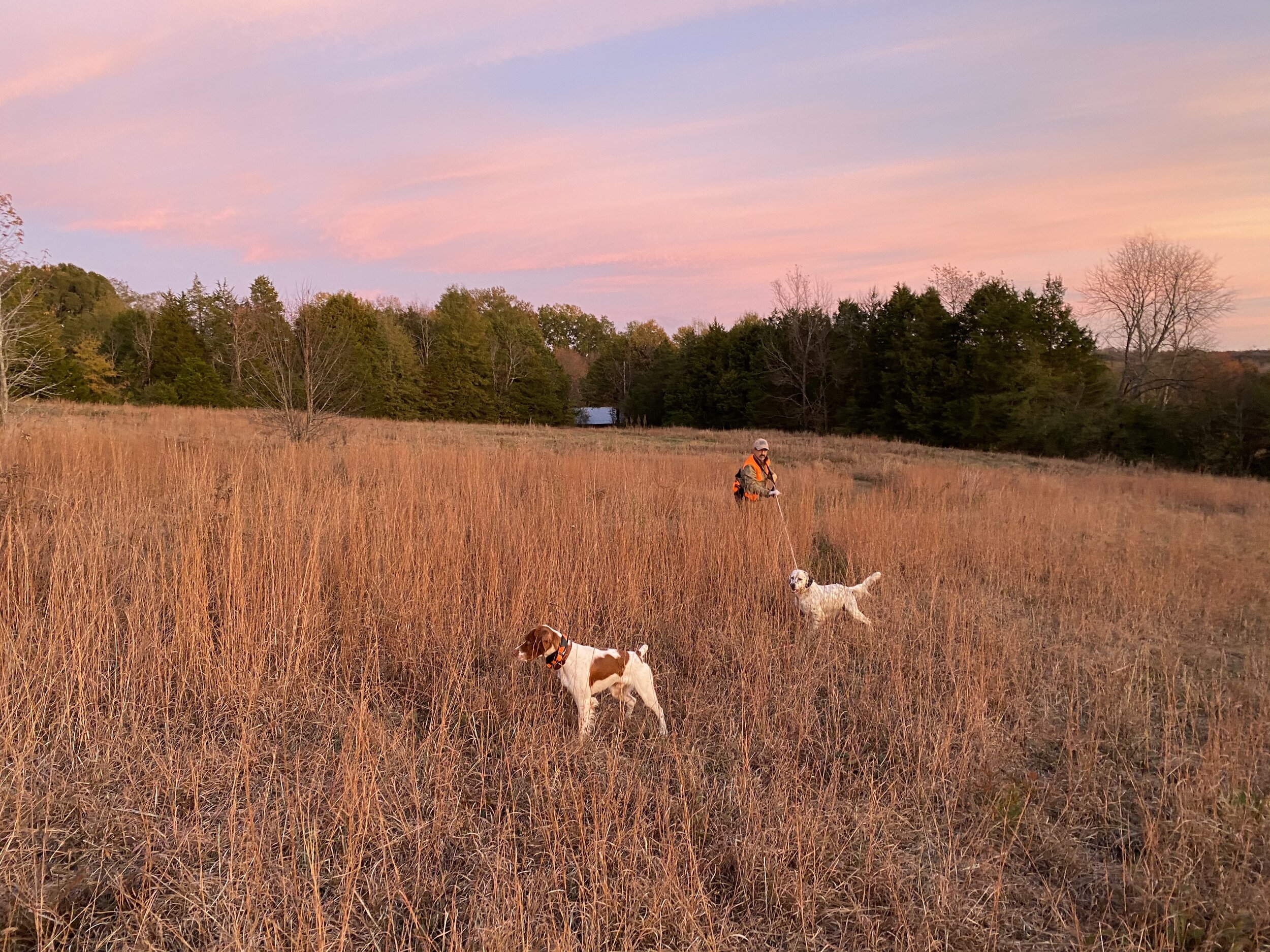
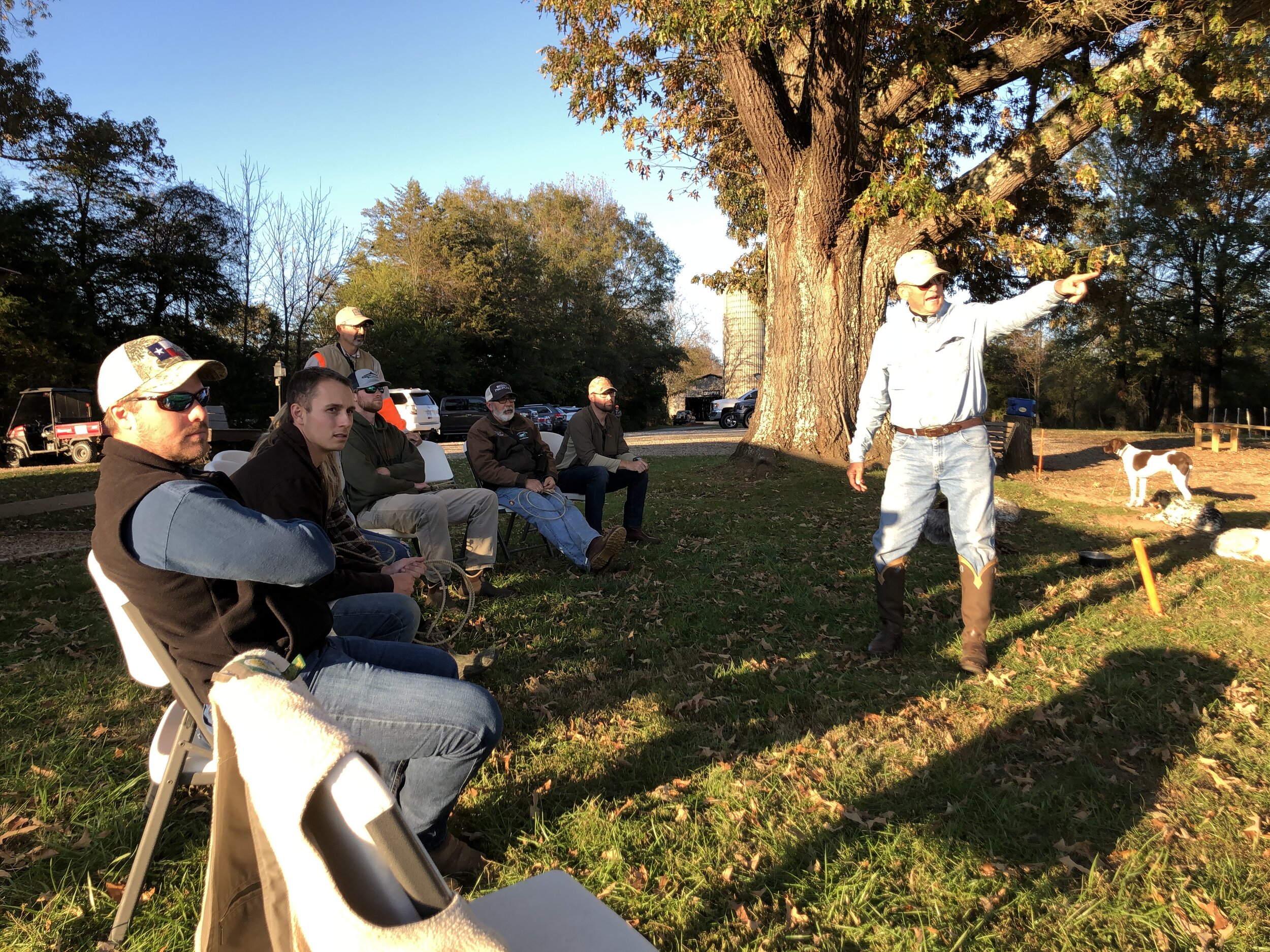


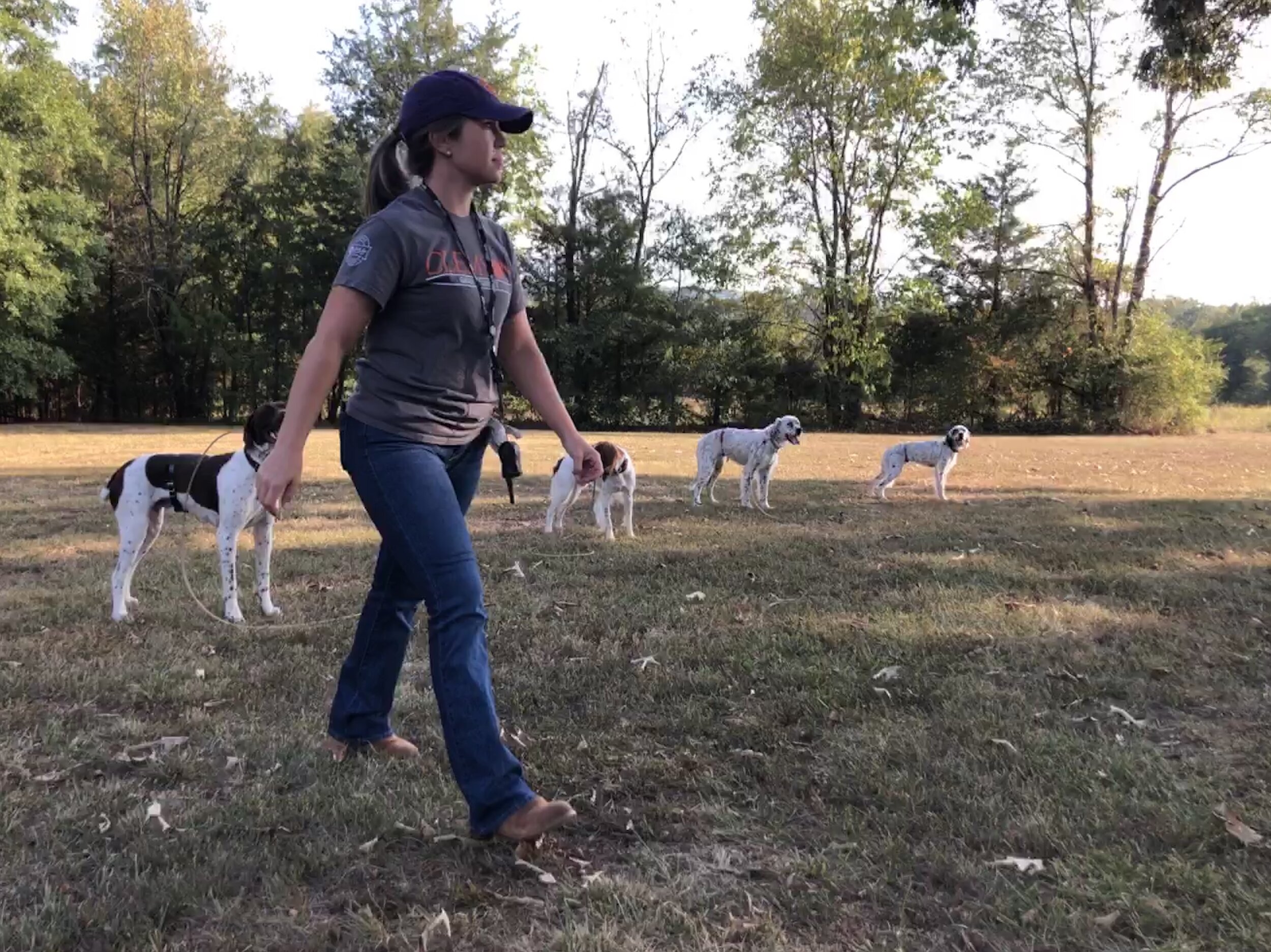
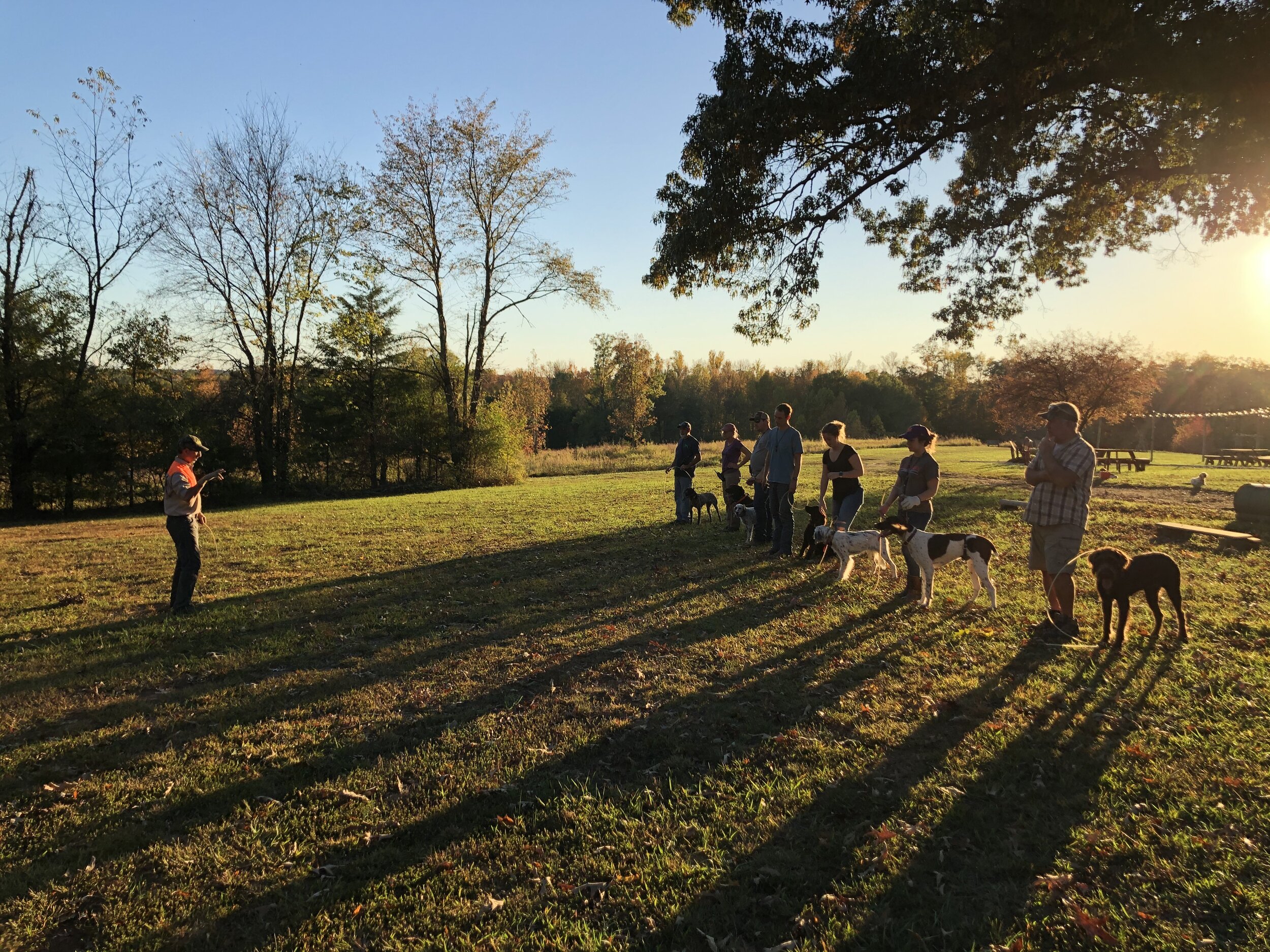

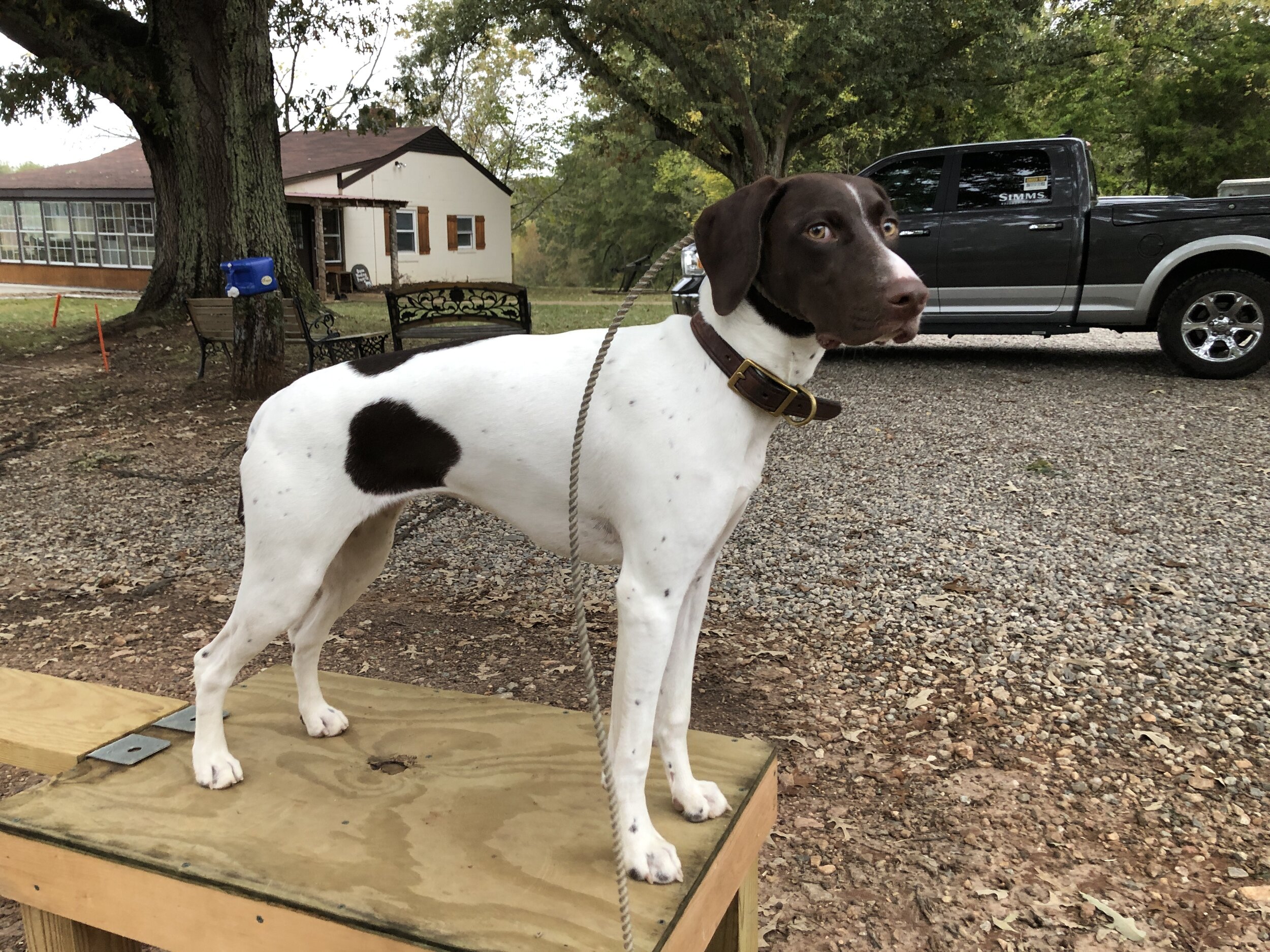



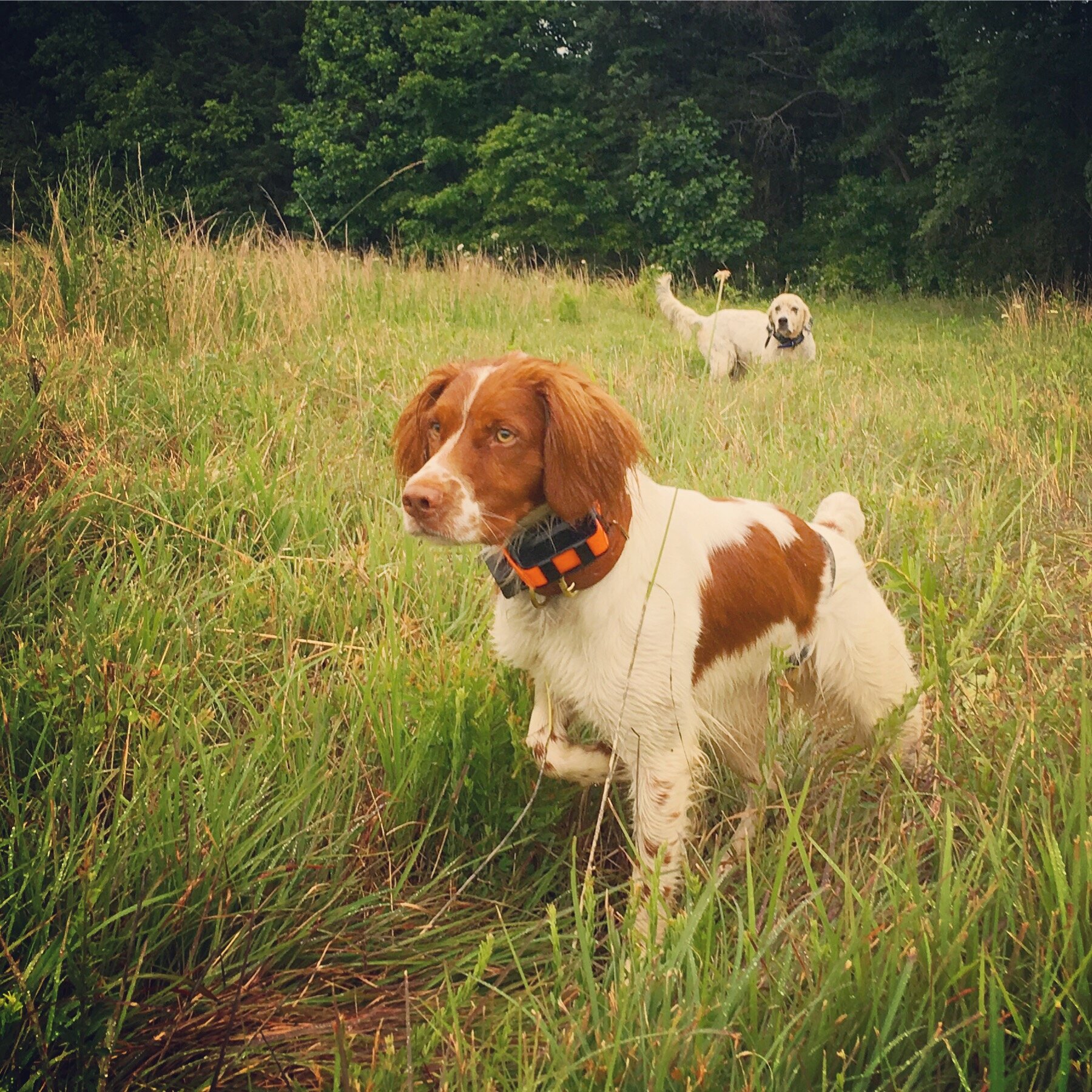
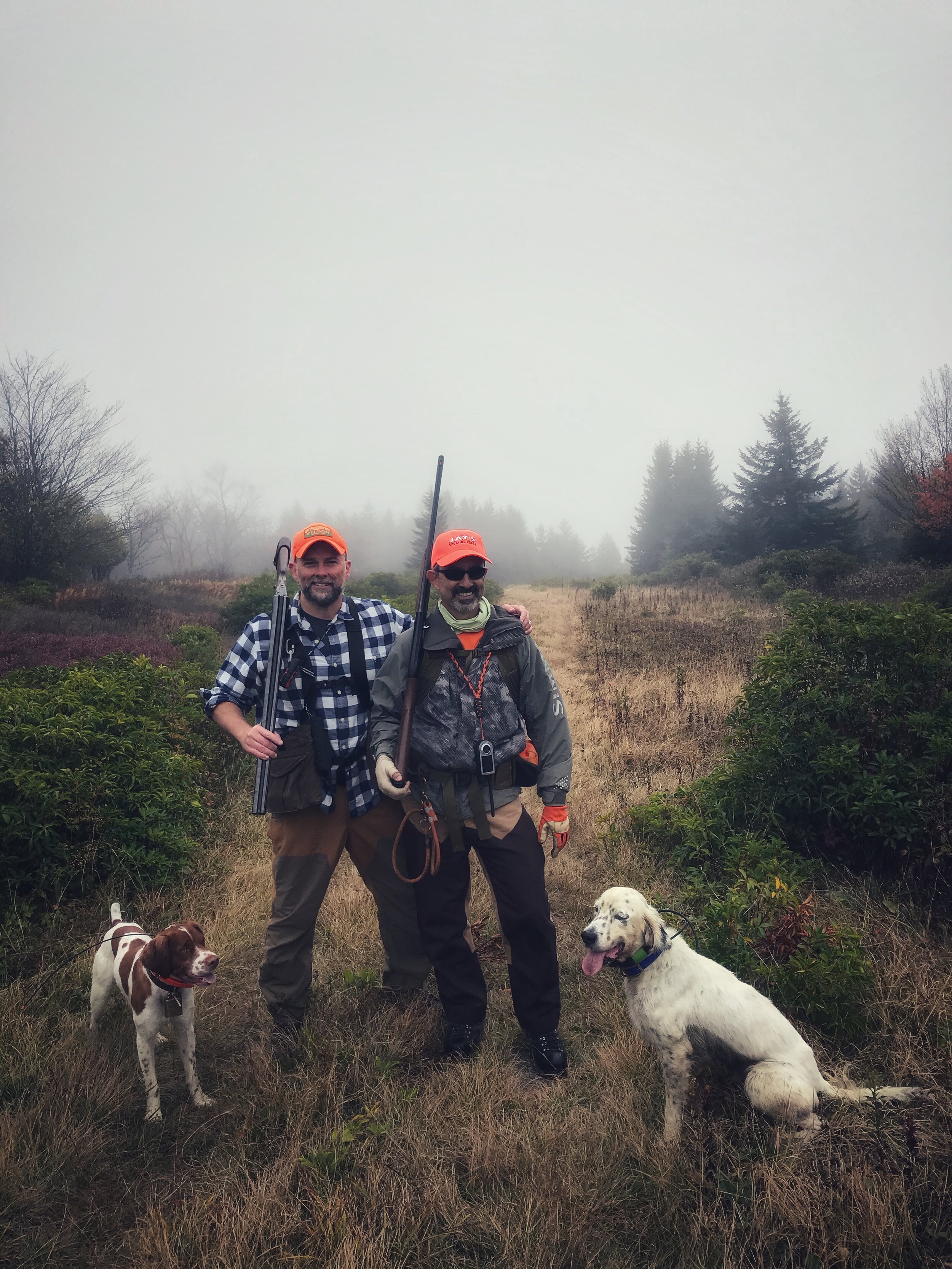
The Huntsmith Training Method: what sets it apart
For any who might have prejudices about the Huntsmith whoa post and flank collar and the yard work the system demands to be mastered, I can assure you it’s really hard to argue with the striking and nearly miraculous results you witness with Rick and the dogs at his seminars. Participants get a chance to see specific and illuminating examples of leading dogs to do things they often want to do but need help doing, and more importantly, things they DON’T initially want to do, especially with dogs who seem like the toughest cases, ones that lesser trainers would surely give up on. Rick’s hands-on work with the dogs demonstrates that a handler who is willing to be the sort of fair, consistent, yet demanding leader dogs naturally want and need actually puts dogs at ease. While never abusive (Rick is very careful that handlers should ALWAYS take care to avoid interacting with a dog out of anger or frustration - and to always stop training for the day when a handler feels those dangerous emotions start to emerge), corrections and aversive techniques are inevitably required to break through dog’s questioning of whether the human handler is a worthy leader of his or her pack. Being the kind of leader dogs are hard-wired to expect and accept allows them to immediately and visibly release anxiety that can get in the way of their ability to learn what we’re trying to teach them. Rick teaches that when we fail to be the sort of leader our dogs need, they will always seek to fill that perceived void with their own resistance-as-leadership when they suspect it might be required: “Somebody has to be the leader here, and I’m not seeing it, so it must be me!” That this sort of dog-centric leadership demands our willingness to deliver effective corrections is a very tough lesson for many of us to accept. But it’s one we might more easily intuit if we’re willing to do what Rick suggests by carefully observing dogs with one another, mothers teaching pups, and littermates and workmates leading and correcting each other. Such careful observation reveals that quick, dispassionate moments of correction spare all involved protracted and painful struggles for clear leadership, which is the very thing dogs most need to feel at ease and content.
To be honest, I still struggle with that lesson - often. But I’ve come to see that struggle as good. In the final analysis, it’s really all about balance and discernment as you learn to read your dog, sorting what’s universally dog from what’s unique about your dog and learning to give your dog the sort of leadership he or she craves and needs. Anyone who has spent much time around Rick will hear him draw upon his many decades of experience to say that it used to be that most trainers and handlers relied far too much on harsh corrections to bend (or “break”) dogs to their will. That process tragically sacrificed dogs on the training altar, either figuratively by removing dogs with unrealized potential from a sporting and working life or brutally and literally by culling those dogs that couldn’t or wouldn't conform under punishingly harsh techniques.
It is important to note that Delmar and the entire Smith family were hugely influential as counter-cultural forces in moving the dog training world away from ineffectively harsh and abusive techniques and arguing for better, more effective, and less harsh methods that could work with all dogs and not just the precious few who could survive a gauntlet of harsh training techniques. But to hear Rick tell it, new owners are now far less less likely to start off as abusive and the reactionary pendulum today has swung too far in the other direction. The dogs Rick and Ronnie see at the beginning of their seminars are now far more likely to start off completely coddled and allowed to set the agenda with their human handlers, a situation that without intervention (hopefully supplied in the seminars) will set up a lifetime of nagging and frustration for both canine and human. Ironically, a long road of coddling will often end with neglect, mistreatment, or dogs surrendered at shelters as owners act out of frustration, anger, and desperation, driven by their failure to be the leader required to address their dogs’ troubling (but very natural) behaviors. Ultimately, Rick argues in all things for balance, and suggests there is peril in either extreme coddling or harsh treatment. He teaches that dogs are denied their full potential whenever we don’t skillfully adjust our methods to the individual dogs’ personalities and dispositions and whenever we as their handlers, trainers, and mentors don’t get the balance right in using each of the modalities of operant conditioning to impact and shape behavior.
Teaching dogs to stand still (or to sit still in the case of flushing dogs) even with the distraction of other dogs and people. Magic!
Manners, obedience, and yard work are foundational elements of the Huntsmith system and are woven into every stage of the system, from the moment a bird dog puppy is picked up at eight weeks through puppy development and into field introduction and field work with birds. I think that’s what differentiates it most from other training philosophies, the most popular of which to my eye also seem very capable of getting a truly dedicated beginning trainer to achievement of their field goals for their canine partners. I should note here the system and philosophy that, in concern for the welfare of the dogs, shares much of what I love about Huntsmith and is my favorite alternative system for strictly field-training for bird dogs: West-Gibbons-Lindley, also commonly referred to as the Steady With Style method. You’ll find my overview and what I love about it in a prior post. Please also note that everything I might have to offer in comparing and contrasting systems is from a relative beginner trying to figure things out, and I offer the frank admission that I might be credibly accused of breaking an almost cardinal rule in starting out: “don’t mix and flip between systems!”
I’m by nature and disposition a universalist and a comparativist, whether it relates to History of Religion where I have professional training as an academician or as a practitioner and clergy of all things GOD from my birth tradition as a Christian of the Southern Baptist variety to an adult as an Anglican Christian and semi-Buddhist, and to the other great - though recently acquired - religion of my middle years: DOG. Make of all that what you will. Life for me is wondrous, rich, complex, and largely ineffable. For me, religions and dog training philosophies (which might as well be religions for all the argument they can inspire) are no different. Learning about and keeping other paths in view is not necessarily a bad thing, particularly for those whose learning style requires it. Put simply, I know myself well enough to know that I learn best in comparative study. While systems - philosophical, practical, theological or otherwise - have internal interdependent logic elements that can’t be pulled apart and exchanged with the constituent conceptual parts of other systems willy-nilly, they can in fact sometimes find meaningful intersections with, overlap with, and/or complement other systems as long as that’s done carefully and with humility.
With that comparative lens in place, to my eye, it’s the foundational focus on rigorous manners and obedience that most sets Huntsmith apart and is what captured my attention as the system and method I needed to incorporate for me and Lincoln. It is ideally suited for people like me who have dogs as cherished family companions and pets first, but who also wish to fully engage them in the demanding field pursuits for which hundreds of years of breeding and genetics have primed them and, by consequence, which these dogs undoubtedly most enjoy pursuing themselves. For while it is true that there are many other things they could enjoy almost as much (agility, dock-diving, etc.) as long as they are given a job and a daily outlet for their minds and energy, it’s hard to deny that, for most bird dogs, working the field and birds come first. Combined with the more-than-I-deserve access to Rick Smith, the leading and world-renowned progenitor of the system, the Huntsmith prerequisite of in-home and yard work obedience and subsequent field and bird work is ideally suited to my family and has made the Huntsmith Training Method the core of my and Lincoln’s lifelong work together. For my very good boy who is often spoiled with love (and even access to snooze at the foot of our bed), this philosophy and system provides us with the contextual boundaries that help Lincoln distinguish between when he can relax as a member of our family and when he’s being asked to do a job (enforced in the home and in the yard as consistently as if he were pointing birds). And it’s under the wisdom of this system, with a full range of resources for us here in Virginia, that I know we’ll continue to grow together as the best possible companions to one another in the life-giving warmth of our home as well as the best possible partners pursuing wing and feather in the life-enhancing magic and mysteries of forest and field.
Addendum: a year’s worth of Huntsmith Training Method lessons
While my time this past year with Rick Smith and Neal Kauder is still fresh, I’ve jotted down a grab bag of lessons I’ve internalized at this stage in my journey, starting with the Huntsmith DVDs, my first meeting and conversations with Rick, and extended through his foundation seminar, Rick Smith’s and Sharon Potter’s regular “Trainin’ Dogs with Rick Smith” column in The Pointing Dog Journal, and later more work with Rick while I have been serving as a training assistant to Neal Kauder in teaching his own Huntsmith-inspired methods at Orapax. Some are quotes, some are paraphrases, some are just things I’ve learned from Rick and Neal and Huntsmith along the way, watching masters at work. Another outstanding just-published resource that I’m only beginning to draw upon (because I’ve just started reading it) that I shouldn’t neglect to mention here is Training Bird Dogs with Ronnie Smith Kennels: Proven Techniques and an Upland Tradition. Finally, if you’re looking for a window into the world of Smith dog training prior to the invention and introduction of variable ecollars capable of cuing and not just correcting, I’d recommend that you get your hands on a copy of Best Way to Train Your Gun Dog: The Delmar Smith Method as it has helped me understand some of the Huntsmith concepts and ecollar methods even better having now read about their manual, analogue predecessors. I’m passing along this list of lessons I’ve picked up from all these sources in case it’s of help to other beginning Huntsmith Silent Command System students as a summary supplement to the DVDs and seminars and weekly lessons at Orapax:
For field success, we only have to teach our dogs three things: Go with us, come to us, and be still. Every aspect of working bird dog training can be traced back to these three simple tasks.
Adapt your training for your dog’s stage of development. Let puppies be puppies, but don't neglect critical puppy development tasks (many of them are fun and stress-free for the pup - like simply running in the field and chasing birds after good bird introduction) that will set them up for later success in formal training.
In formal training, firmly establish your leadership and deal with a dog’s resistance and behaviors in the obedience and yard work tasks so by the time you hit the field and birds, you’re using much lower levels of pressure with the ecollar and are much less likely to create the sorts of thorny problems a heavy hand around birds is prone to create.
Dogs aren’t native English speakers and if you pay attention, you’ll discover they never use it with each other. So keep your mouth shut and teach your dog through doing and manual corrections and cues. The overlay of the verbal command (if you insist on needing one) is the very LAST step, not the first.
Once you’ve overlayed a verbal command, take great care to use it ONCE and do not repeat it for your dog to comply. If that fails or you have to repeat it, you need to back up to the ecollar cue or correction, or all the way back to the prerequisite wonder lead or check cord manual commands.
Whenever possible, help a dog progress through its natural resistance by helping the dog understand it can turn on or turn off pressure through its own behavior.
A dog’s bad behaviors and problems always says more about the handler / trainer than they do about the dog. For the humans, humility and the ability to learn and improve is an absolute requirement. Our dogs are much better at that than we are.
The more consistent and fair we are as handlers, the more quickly our dog will learn and the better behaved it will be.
The more inconsistent and erratic we are, the more problems our dog will develop.
In all things, balance! Training episodes with demanding tasks and/or tough new lessons need to be balanced with activities the dog enjoys and finds less stressful to keep the dog (and the handler) loose.
Always stop whenever you find yourself getting frustrated or angry (and this will at some point happen to all of us - but those who can’t control their anger and frustration should avoid having a dog).
Trust the process, follow the steps.
When you and your dog meet with a road block of failure, you’ve pushed too far and you only need to back up to the previous steps until you and your dog again encounter success.
Stay there until your dog seems sure and you seem sure, then forge ahead again.
Try to always end training sessions on positive notes with success, again, backing up a step or several steps if necessary (exception to this: if you’re getting frustrated or angry - then it might be better to just stop for the day).
Rinse and repeat.
When delivering ecollar corrections during yard work or obedience tasks (chain gang quietness is a good example), you have to be initially willing to go to the price a dog isn’t willing to pay to continue resisting what it’s being asked to do or what it is being asked not to do. But, you have to be equally willing to immediately lower that pressure when the lesson has been delivered. Most Smith method dogs, even the toughest customers, can be brought along to respond to mere cues from an ecollar on its lowest settings - at levels a human may not even be able to feel, much less find unpleasant. At that point, the ecollar has therefore become a cue device only and not a corrective device.
NEVER correct a dog unless you are SURE it understands what you are asking it to do, or not do and it is refusing to comply. Often, non-compliance results from a trainer not doing enough to ensure the dog understands what the trainer is asking/commanding - and corrections in this situation can really cause things to go sideways.
Any long-sustained need to use an ecollar as a corrective device beyond introduction to tasks and early lessons in a particular task should be a serious danger sign to the handler that something is broken in the training program and/or handler’s leadership and application, NOT in the dog. Go back, figure out where the breakdown occurred, perhaps to manual corrections before any attempt to overlay the ecollar as cue again.
When you encounter a problem in the field and with birds, your dog either doesn’t understand what you are asking or your leadership in the yard and at home has faltered. Figure that out and go back to home or yard to address those problems first.
Sometimes it’s steps forward, sometimes it’s steps backward, but for a dedicated and diligent handler, the overall momentum forward wins the day or the week or the month.
There’s no race, only the pace that’s right for you and your dog.
While every dog has a unique personality and disposition and unique set of life experiences, Smith trainers will tell you they all are also universally DOG. They therefore have a set range of behaviors and tricks up their furry sleeves. If you have a problem with your dog, you can be sure an experienced trainer has seen it before and a great trainer knows just how to diagnose and correct it. Call upon expert help when you need it (facebook posts definitely don’t count - call, or better yet, do it in person).
Sometimes you’re just waiting on your dog to mature, sometimes you’re waiting for your own hard-headedness and lack of patience to dissipate to get into the right flow for whatever your dog is ready for and avoid anything for the moment for which you and your dog aren’t yet ready.
Be prepared to take many months, even 2-3 years to fully finish your dog yourself - while it’s theoretically possible for finish a dog in a single season, such a dog will often get burned out from too much pressure and may end up having its joy for the field ruined. There are much worse things than going too slow.
Know that you’re never really finished - training is a life-long task for you and your dog, often needing tune ups and reinforcement of earlier established lessons.
Dogs ultimately never forget what they’ve learned, good or bad. It’s all there, either to be recovered or to be muted by a skilled hand, but always there.

